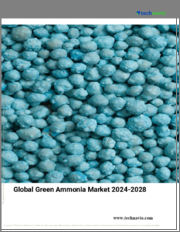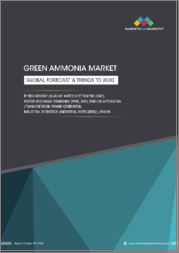
|
시장보고서
상품코드
1572478
그린 암모니아 시장 : 기회, 성장 동인, 산업 동향 분석 및 예측(2024-2032년)Green Ammonia Market, Opportunity, Growth Drivers, Industry Trend Analysis and Forecast, 2024-2032 |
||||||
2023년 세계 그린 암모니아 시장 규모는 약 3억 2,020만 달러로 평가되었고, 2024년부터 2032년까지 연평균 66.3% 이상 성장할 것으로 예상됩니다.
전 세계 각국 정부와 조직은 탄소 배출량을 줄이기 위해 탈탄소화 노력을 우선순위에 두고 있습니다. 재생 가능 에너지원에서 추출한 그린 암모니아는 농업(비료), 운송(연료) 등의 분야에서 중요한 역할을 하고 있습니다. 최근 전해조와 재생 가능 에너지의 통합에 대한 기술 발전으로 생산 비용이 크게 감소했습니다. 강화된 촉매 및 고체 산화물 전해조와 같은 기술 혁신은 더 높은 효율과 확장성을 가져와 녹색 암모니아를 더욱 실용적으로 만들고 있습니다. 그린 수소 경제가 확대됨에 따라 녹색 암모니아에 대한 수요도 증가하고 있습니다.
기술에 따라 시장은 광촉매, 전기분해, 생물학적 질소 고정으로 구분됩니다. 전기분해는 2023년 1억 9,890만 달러의 압도적인 시장 점유율을 차지할 것으로 예상되며, 2032년까지 연평균 65%로 크게 성장할 것으로 전망됩니다. 전해 기술이 시장을 독점하고 있는 이유는 암모니아 생산의 주요 성분인 수소 생성에 효과적이기 때문입니다. 편리함과 긴 수명으로 알려진 알칼리성 물 전기 분해는 확립된 비용 효율적인 방법입니다. 양성자 교환막 전기분해는 높은 효율과 태양광, 풍력 등 재생 가능 에너지원과의 호환성이 뛰어납니다.
최종 용도에 따라 시장은 농업, 전력 및 에너지, 운송, 화학, 기타(제약, 섬유)로 분류됩니다. 농업 부문은 2023년 58.6%의 주요 시장 점유율을 차지할 것으로 예상되며, 2032년까지 연평균 65%의 성장률을 보일 것으로 전망됩니다. 농업 부문은 비료 용도로 암모니아에 대한 의존도가 높기 때문에 시장을 지배하고 있습니다. 이 분야에서 그린 암모니아에 대한 수요 증가는 전통적인 암모니아 생산과 관련된 탄소 배출량을 줄이려는 노력으로 인해 증가하고 있습니다.
유럽은 지속가능성과 탈탄소화에 중점을 두고 있기 때문에 시장을 선도하고 있습니다. 강력한 정부 정책과 재생에너지 인프라에 대한 막대한 투자가 이 시장의 주도권을 뒷받침하고 있습니다. 유럽에서는 2050년까지 순배출량 제로를 목표로 하는 유럽 그린딜(European Green Deal) 등의 노력으로 인해 그린 암모니아에 대한 높은 수요가 발생하고 있습니다. 북미도 이 분야에서 큰 진전을 보이고 있으며, 그린 암모니아 프로젝트에 대한 투자가 증가하고 있습니다. 그러나 북미는 높은 선행 비용과 인프라 제약으로 인해 발전이 더디게 진행되고 있습니다. 이러한 문제에도 불구하고, 두 지역은 그린 암모니아 시장을 발전시키는 데 있어 매우 중요한 지역임에는 변함이 없습니다.
목차
제1장 조사 방법과 조사 범위
제2장 주요 요약
제3장 업계 인사이트
- 생태계 분석
- 주요 제조업체
- 유통업체
- 업계 전체 이익률
- 업계에 대한 영향요인
- 성장 촉진요인
- 시장이 해결해야 할 과제
- 시장 기회
- 새로운 기회
- 성장 가능성 분석
- 원료 상황
- 제조 동향
- 기술 진화
- 원재료의 지속가능성
- 지속가능한 제조
- 그린 프랙티스
- 탈탄소화
- 가격 동향(달러/톤), 2021-2032년
- 규제와 시장에 대한 영향
- Porter's Five Forces 분석
- PESTEL 분석
제4장 경쟁 구도
- 서론
- 기업 매트릭스 분석
- 기업 점유율 분석
- 지역별 기업 점유율 분석
- 북미
- 유럽
- 아시아태평양
- 라틴아메리카
- 중동 및 아프리카
- 지역별 기업 점유율 분석
- 경쟁 포지셔닝 매트릭스
- 전략 대시보드
제5장 시장 규모와 예측 : 기술별, 2021-2032년
- 주요 동향
- 전해
- 양성자 교환막(PEM) 전해
- 알칼리수 전해(AWE)
- 고체 산화물 전해(SOE)
- 광촉매
- 생물학적 질소 고정
제6장 시장 규모와 예측 : 최종 용도별, 2021-2032년
- 주요 동향
- 농업
- 전력 및 에너지
- 운송
- 화학
- 기타(제약, 텍스타일 등)
제7장 시장 규모와 예측 : 지역별, 2021-2032년
- 주요 동향
- 북미
- 미국
- 캐나다
- 유럽
- 독일
- 영국
- 프랑스
- 이탈리아
- 스페인
- 기타 유럽
- 아시아태평양
- 중국
- 인도
- 일본
- 한국
- 호주
- 기타 아시아태평양
- 라틴아메리카
- 브라질
- 멕시코
- 아르헨티나
- 기타 라틴아메리카
- 중동 및 아프리카
- 사우디아라비아
- 아랍에미리트(UAE)
- 남아프리카공화국
- 기타 중동 및 아프리카
제8장 기업 개요
- MAN Energy Solutions
- Air Products Inc
- BASF SE
- Haldor Topsoe
- Hiringa Energy
- Hydrogenics
- Kapsom
- Nel Hydrogen
- Siemens Energy
- Starfire Energy
- Technip Energies NV
- ThyssenKrupp AG
- Uniper ENGIE
- Yara International
The Global Green Ammonia Market was valued at approximately USD 320.2 million in 2023 and is anticipated to witness a CAGR of over 66.3% from 2024 to 2032. Governments and organizations around the globe are prioritizing decarbonization efforts to cut carbon emissions. Green ammonia, derived from renewable energy sources, plays a vital role in sectors such as agriculture (fertilizers) and transportation (fuel). Recent technological advancements in electrolyzers and the integration of renewable energy have notably reduced the cost of production. Innovations like enhanced catalysts and solid oxide electrolyzers are driving greater efficiency and scalability, making green ammonia more practical. As the green hydrogen economy expands, the demand for green ammonia is also rising.
The overall green ammonia industry is classified based on the technology, end-use, and region.
Based on technology, the market is segmented into photocatalysis, electrolysis, and biological nitrogen fixation. Electrolysis held a dominant market share of USD 198.9 million in 2023 and is expected to grow significantly with a CAGR of 65% by 2032. Electrolysis technologies dominate the market because of their effectiveness in generating hydrogen, a key component for ammonia production. Alkaline water electrolysis, known for its simplicity and long lifespan, is a well-established and cost-efficient method. Proton exchange membrane electrolysis stands out for its high efficiency and compatibility with renewable energy sources such as solar and wind.
Based on end use, the market is segmented into agriculture, power and energy, transportation, chemicals, and others (pharmaceuticals and textiles). Agriculture accounted for a major market share of 58.6% in 2023 and is projected to grow through 2032 at a CAGR of 65%. The agriculture sector dominates the market, driven by its widespread reliance on ammonia for fertilizer applications. The growing demand for green ammonia in this sector is fueled by efforts to lower the carbon footprint associated with conventional ammonia production.
Europe leads the market due to its strong focus on sustainability and decarbonization. Strong government policies and substantial investments in renewable energy infrastructure underpin this market leadership. In Europe, initiatives such as the European Green Deal, which targets net-zero emissions by 2050, are fueling the high demand for green ammonia. North America is also making strides in this area, with increasing investments in green ammonia projects. However, the region faces slower progress due to higher upfront costs and infrastructure limitations. Despite these challenges, both regions remain pivotal in driving the green ammonia market forward.
Table of Contents
Chapter 1 Methodology and Scope
- 1.1 Market scope and definition
- 1.2 Base estimates and calculations
- 1.3 Forecast calculation
- 1.4 Data sources
- 1.4.1 Primary
- 1.4.2 Secondary
- 1.4.2.1 Paid sources
- 1.4.2.2 Public sources
Chapter 2 Executive Summary
- 2.1 Industry 360° synopsis
Chapter 3 Industry Insights
- 3.1 Industry ecosystem analysis
- 3.1.1 Key manufacturers
- 3.1.2 Distributors
- 3.1.3 Profit margins across the industry
- 3.2 Industry impact forces
- 3.2.1 Growth drivers
- 3.2.1.1 Growing decarbonization initiatives
- 3.2.1.2 Continuous advancements in electrolyser technologies and renewable energy integration
- 3.2.1.3 Emerging green hydrogen economy
- 3.2.2 Market challenges
- 3.2.2.1 High initial investment costs
- 3.2.2.2 Transitioning to green ammonia requires substantial modifications and investments in new supply chains, storage facilities, and transportation networks
- 3.2.3 Market opportunity
- 3.2.3.1 New opportunities
- 3.2.3.2 Growth potential analysis
- 3.2.1 Growth drivers
- 3.3 Raw material landscape
- 3.3.1.1 Manufacturing trends
- 3.3.1.2 Technology evolution
- 3.3.1.3 Sustainability in raw materials
- 3.4 Sustainable manufacturing
- 3.4.1.1 Green practices
- 3.4.1.2 Decarbonization
- 3.5 Pricing trends (USD/Ton), 2021 to 2032
- 3.5.1.1 North America
- 3.5.1.2 Europe
- 3.5.1.3 Asia Pacific
- 3.5.1.4 Latin America
- 3.5.1.5 Middle East and Africa
- 3.6 Regulations and market impact
- 3.7 Porter's analysis
- 3.8 PESTEL analysis
Chapter 4 Competitive Landscape, 2023
- 4.1 Introduction
- 4.2 Company matrix analysis
- 4.3 Company market share analysis
- 4.3.1 Company market share analysis by region
- 4.3.1.1 North America
- 4.3.1.2 Europe
- 4.3.1.3 Asia Pacific
- 4.3.1.4 Latin America
- 4.3.1.5 Middle East Africa
- 4.3.1 Company market share analysis by region
- 4.4 Competitive positioning matrix
- 4.5 Strategic dashboard
Chapter 5 Market Size and Forecast, By Technology, 2021-2032 (USD Million, Kilo Tons)
- 5.1 Key trends
- 5.2 Electrolysis
- 5.2.1 Proton exchange membrane (PEM) electrolysis
- 5.2.2 Alkaline water electrolysis (AWE)
- 5.2.3 Solid oxide electrolysis (SOE)
- 5.3 Photocatalysis
- 5.4 Biological nitrogen fixation
Chapter 6 Market Size and Forecast, By End Use, 2021-2032 (USD Million, Kilo Tons)
- 6.1 Key trends
- 6.2 Agriculture
- 6.3 Power and energy
- 6.4 Transportation
- 6.5 Chemicals
- 6.6 Others (including pharmaceutical, textiles, etc.)
Chapter 7 Market Size and Forecast, By Region, 2021-2032 (USD Million, Kilo Tons)
- 7.1 Key trends
- 7.2 North America
- 7.2.1 U.S.
- 7.2.2 Canada
- 7.3 Europe
- 7.3.1 Germany
- 7.3.2 UK
- 7.3.3 France
- 7.3.4 Italy
- 7.3.5 Spain
- 7.3.6 Rest of Europe
- 7.4 Asia Pacific
- 7.4.1 China
- 7.4.2 India
- 7.4.3 Japan
- 7.4.4 South Korea
- 7.4.5 Australia
- 7.4.6 Rest of Asia Pacific
- 7.5 Latin America
- 7.5.1 Brazil
- 7.5.2 Mexico
- 7.5.3 Argentina
- 7.5.4 Rest of Latin America
- 7.6 MEA
- 7.6.1 Saudi Arabia
- 7.6.2 UAE
- 7.6.3 South Africa
- 7.6.4 Rest of MEA
Chapter 8 Company Profiles
- 8.1 MAN Energy Solutions
- 8.2 Air Products Inc
- 8.3 BASF SE
- 8.4 Haldor Topsoe
- 8.5 Hiringa Energy
- 8.6 Hydrogenics
- 8.7 Kapsom
- 8.8 Nel Hydrogen
- 8.9 Siemens Energy
- 8.10 Starfire Energy
- 8.11 Technip Energies NV
- 8.12 ThyssenKrupp AG
- 8.13 Uniper ENGIE
- 8.14 Yara International



















